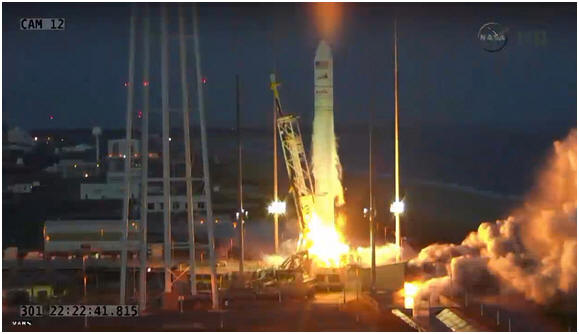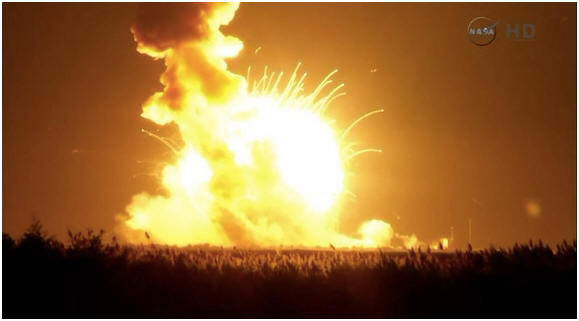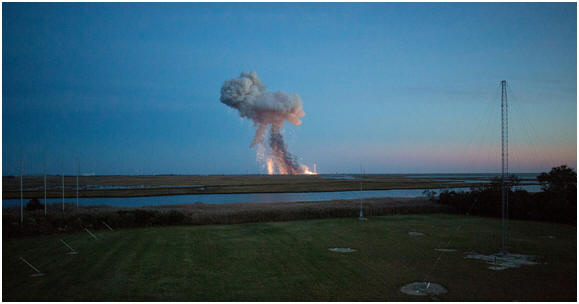www.aljazeerah.info
News, November 2014
Archives
Mission & Name
Conflict Terminology
Editorials
Gaza Holocaust
Gulf War
Isdood
Islam
News
News Photos
Opinion Editorials
US Foreign Policy (Dr. El-Najjar's Articles)
www.aljazeerah.info
|
Editorial Note: The following news reports are summaries from original sources. They may also include corrections of Arabic names and political terminology. Comments are in parentheses. |
NASA Contractor Orbital Antares Rocket, Heading to International Space Station, Explodes Just After Launch on October 28, 2014
November 1, 2014
 |
 |
 |
 |
Right click on photos for information about them
Orbital Sciences Piecing Together Timeline of Antares Rocket Explosion
by Miriam Kramer, Space.com
October 31, 2014 01:20pm ET
Editor's Note:
NASA officials are urging residents of the area around the launch site to keep away from any rocket debris that might wash up on shore or found on land. If you think you may have found pieces of the rocket, or if your property sustained damage from the failed launch, please call the incident response team at (757) 824-1295.
***
Private spaceflight company Orbital Sciences Corp. is starting to piece together the timeline of events leading up to the explosion of its Antares rocket just after launch on Tuesday evening (October 28, 2014).
People working with Orbital are still in the process of investigating the root cause of the Antares failure. No one was hurt in the explosion, but the rocket was carrying an unmanned Cygnus spacecraft expected to deliver supplies to the International Space Station for NASA when the accident occurred. According to an Orbital update released Thursday (Oct. 30), the rocket seemed to perform normally until about 15 seconds after launch, when some as-yet-unknown variable caused the rocket to catastrophically fail.
"Evidence suggests the failure initiated in the first stage after which the vehicle lost its propulsive capability and fell back to the ground impacting near, but not on, the launch pad," Orbital Sciences representatives wrote in an update. The rocket was launching from a pad at NASA's Wallops Flight Facility on Wallops Island, Virginia. [See images of the Antares explosion]
Orbital Sciences holds a $1.9 billion contract with NASA to fly eight robotic missions to the International Space Station using Cygnus and Antares. The launch Tuesday (if it had been successful) would have started the company's third official resupply trip to the station.
Company representatives are also surveying the damage caused by the accident. An Orbital safety team found that a "significant amount of debris" is still located around the site of the failure, and the company might be able to use that evidence to aid in their investigation, Orbital representatives said.
"Some of the Cygnus cargo has also been found and will be retrieved as soon as we have clearance to do so to see if any survived intact," Orbital representatives said in the same update. "After up close visual inspections by the safety team, it still appears the launch site itself avoided major damage. There is some evidence of damage to piping that runs between the fuel and commodity storage vessels and the launch mount, but no evidence of significant damage to either the storage vessels or launch mount."
Crewmembers on the space station still have plenty of supplies on the orbiting laboratory, so there is no immediate danger posed by the Cygnus loss, NASA officials have said.
The space station astronauts have had to rearrange some of their plans in light of the rocket failure, however. Officials with the European Space Agency said there will now be a need to alter how trash is stored in Europe's Columbus module on the station.
Cygnus spacecraft are designed to burn up harmlessly in Earth's atmosphere after leaving the space station at the end of missions, meaning that astronauts can load the spacecraft up with things they no longer need.
"The unglamorous fact is that we now need to rework our trash and stowage choreography for Columbus," ESA officials wrote in an Oct. 30 blog post. "We had a strategy in place to operate efficiently but now we have to work with the trash we cannot get rid of with Orbital-3!"
***
during liftoff during a mission to deliver cargo to the
International![]() Space Station for NASA.
Space Station for NASA.
See
photos![]() from the stunning rocket launch failure here. Read the Full
Story:
from the stunning rocket launch failure here. Read the Full
Story:
Private Orbital Sciences Rocket Explodes During Launch, NASA Cargo Lost
NASA has released a series of photos of the Orbital Sciences rocket explosion taken
by photographer Joel Kowsky. Here, the Antares rocket is seen erupting in a giant
fireball about 10 seconds after liftoff.
Credit![]() :
NASA/Joel Kowsky.
:
NASA/Joel Kowsky.
Here, NASA photographer Joel Kowsky captures the moment of a "catastrophic anomaly"
on the Antares rocket just after it lifted off from Pad-0A at the
Wallops Flight
Facility![]()
on Wallops Island, Virginia. The rocket's upper half is clearly visible here, with what appears
to be an explosion near its aft. Credit: NASA/Joel Kowsky.
Another view of the first seconds of the Antares rocket's destruction by NASA
photographer Joel Kowsky. Credit: NASA/Joel Kowsky.
A towering smoke plume rises over Pad-0A at NASA's Wallops Flight Facility after the
explosion of the Orbital Sciences-built Antares rocket. Credit: NASA/Joel Kowsky.
This still image, taken just seconds after the Antares rocket lifted off from Pad-0A
at NASA's Wallops Flight Facility on Wallops Island, Virginia, shows the shocking outcome: a towering fireball as the commercial rocket and its robotic Cygnus spacecraft are destroyed in a fireball shortly after a 6:22 p.m. EDT (2222 GMT) launch. The mission was carrying 5,000 lbs. of cargo bound for the International Space Station - Orbital's third of eight resupply missions under a $1.9 billion contract with NASA. Credit: NASA TV.
The rocket failure occured after a relatively smooth launch countdown. Here the Antares rocket is seen just before liftoff at its seaside launch pad. Orbital Sciences initially tried to launch the Antares rocket on Monday, Oct. 27, but a stray boat wandered into the launch safety range offshore, forcing flight controllers to postpone the launch try. Credit: NASA TV.
At T-0, the Antares rocket's liquid-fueled first stage ignited, lifting the booster off the launch pad as seen here. But within 10 seconds of the launch, the first sign of an anomaly was seen, Orbital Sciences representatives said. Credit: NASA TV.
***
Share this article with your facebook friendsFair Use Notice
This site contains copyrighted material the
use of which has not always been specifically authorized by the copyright
owner. We are making such material available in our efforts to advance
understanding of environmental, political, human rights, economic,
democracy, scientific, and social justice issues, etc. We believe this
constitutes a 'fair use' of any such copyrighted material as provided for
in section 107 of the US Copyright Law. In accordance with Title 17 U.S.C.
Section 107, the material on this site is
distributed without profit to those
who have expressed a prior interest in receiving the included information
for research and educational purposes. For more information go to: http://www.law.cornell.edu/uscode/17/107.shtml.
If you wish to use copyrighted material from this site for purposes of
your own that go beyond 'fair use', you must obtain permission from the
copyright owner.
|
|
|
|
||
|
||||||









